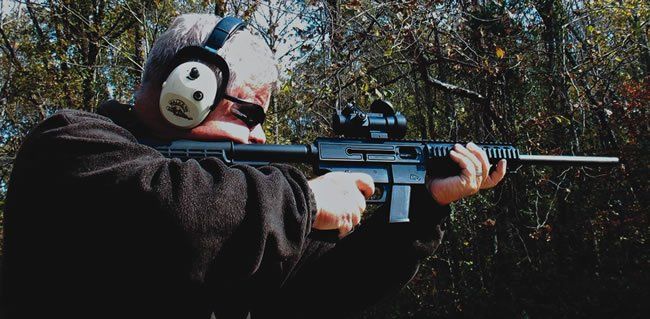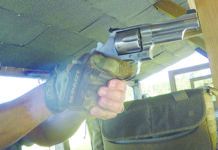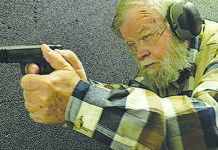
The first time we tested the Just Right Carbine in the June 2014 issue, we had beaucoup malfunctions and gave the rifle a D grade. Yet, the rifle seemed to have promise. Handling was good to excellent, the light-rail well designed, and compatibility with Glock magazines gave good utility. The accuracy test was a struggle due to malfunctions. But we did not have to go through hell and high water to get it working. We sent it back to the factory. When it returned, the JRC carbine was a different bird and sang a pretty tune. And we just may have learned a few things about pistol-caliber carbines in the second test. Make no mistake, it is best when the firearm works the first time, but the Just Right Carbine has potential. Heres what we thought after the follow-up test.
Just Right Carbine (Glock Based) 45 ACP, $773
The JRC doesnt mimic the AR-15s gas operation, only the handling. The JR doesnt use a complicated gas or piston system, but is instead a blowback design. With a carbine using a pistol cartridge, blowback operation is feasible. For more on its features and operation, please see the original story.
At the time of our first test, we found it difficult to fire for accuracy due to feed malfunctions, but we did so, achieving a 1.7-inch 25-yard group with the HPR 230-grain FMJ. It fed this round the best, but not completely reliably. We had saved a representative sample of the same lot number of the HPR 230-grain FMJ (CheaperThanDirt.com, $26.31, 50 rounds.) We also saved a supply of the Winchester 230-grain PDX Defender (CheaperThanDirt.com, $21.70, 20 rounds.) Finally we used the Hornady 220 grain Critical Duty +P. (Cheaper than Dirt, $18.53, 20 rounds.) We were relieved to find that this time, the rifle fired normally. The first magazine was fired into the berm as quickly as we could pull the trigger. This was the HPR FMJ load. When firing the first magazines into the berm, we didnt aim. We were simply burning ammunition for function. We did not hold the stock into the shoulder. A couple of times we had a round feed into the chamber, but the bolt did not cock the firing pin. This was the equivalent of a short cycle with the Glock – shooter error. We put the gun to the shoulder and never had a problem thereafter.
Moving to the two hollowpoint loads, a magazine of each gave similar results. The rifle wasnt proofed yet, but it earned a day at the range.
The same Tasco red-dot sight previously used was mounted. The rifle was fired with a full 50-round box of the HPR 230-grain FMJ load. There were no failures to feed, chamber, fire, or eject using the supplied Glock 13-round magazine. This time we had a much better feel for the carbine. The rifle allowed a trained shooter to reach to the end of the forend and control the carbine in rapid fire and traverse between targets. The Just Right Carbine would be a formidable home-defense firearm. Considering the energy exhibited by 45 ACP loads in this carbine, the JRC equals or exceeds common 44-40 WCF rifle ballistics with factory ammunition. During offhand testing, we also fired 20 rounds each, ten to a magazine, of the Winchester PDX and the Hornady 220-grain +P loads. Recoil remained modest, but we knew that we were firing a +P with the Hornady load. By the time we settled into bench rest firing, we had fired 200 rounds in the JR Carbine, and we enjoyed the ride.
It is a rule of thumb that you do not feed +P loads into blowback pistol-caliber carbines, but that wasnt the cause for the malfunctions with the Hornady +P loads during the first test. During this follow-up, one of our raters picked up the brass for handloading. We routinely check fired brass for excess pressure and firing pin drag marks, and in this case found that a number of the Hornady cases, about 15 percent, showed high-pressure signs. Case-head expansion was not excessive, however. If you need to take advantage of the Hornady loads 664 foot-pounds of energy, use this load sparingly.
We also added a full box of Remingtons 230-grain UMC load after we ran out of the original test loads. Function was flawless, and the rifle performed well with this load.
Settling down to bench-rest fire, we tried the HPR 230-grain FMJ first. The original five-shot average had been 1.7 inches. This time, the accuracy standard was improved, 1.4 inches. The Hornady averaged 1.5 inches, compared to the Thureons 1.3-inch average with this load. The Winchester averaged 1.7 inches in the JRC, compared to the Thureon carbines 1.4 inches. The results were consistent, which make us believe we were shooting right up to the potential of the carbine.
The Just Right carbine also showed a slight advantage in muzzle velocity and energy compared to the Thureon.
Our Team Said: Though the accuracy demonstrated may not be impressive compared to an AR-15, the Just Right Carbine will make a single ragged hole at typical personal-defense distances. Recoil is light, and muzzle report is much more subdued than the .223. As for interchangeability of magazines, if you own a Glock 21, the Just Right is a good idea as a partner carbine. In the end, we find the Just Right Carbine what we were hoping for in the beginning, a reliable and useful firearm.
Written and photographed by R.K. Campbell, using evaluations from Gun Tests team testers. GT
justrightcarbineglockbased45acp.pdf























I have gen3 9mm jrc, after thousands of rounds I have never had a problem. I’ve even shot 500 rounds of 115gr aluminum cased lrn ammo without a single problem.